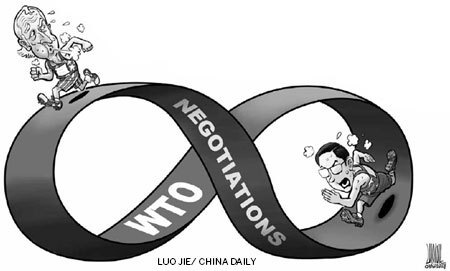
China and the United States will hold formal consultations over the US' countervailing measures against Chinese exports under the WTO dispute settlement mechanism on Wednesday and Thursday. Twenty-two product categories, including steel, solar cells and wind turbine towers, worth a collective $7.3 billion, are involved.
This is another chance for China and the US to use the WTO trade dispute settlement mechanism to resolve their bilateral trade disputes.
Over the past 10 years since China's accession to the WTO in December 2001, China has become the world's second largest trading economy. Accession to the WTO greatly sharpened China's competitive edge in the international trade arena, with Made-in-China products selling well all over the world. China's total volume of exports and imports surged from $509.65 billion in 2001 to $3.64 trillion in 2011, a more than six-fold increase.
From the very beginning the model for China's economy has been export-oriented. And after more than 30 years of ultra-high-speed trade development the volume of its exports and number of different categories has surged, inevitably impacting on the trade of other WTO members.
As a result, trade frictions between China and other countries are becoming increasingly common, in particular with its two largest trading partners, the European Union and the US, especially in the context of the sluggish world economic recovery.
According to data released by the General Administration of Customs on July 10, China's exports to the US reached $165.32 billion in the first half of this year, compared with $163.06 billion to the EU, the US overtaking the EU as the largest buyer of Chinese goods and services.
China needs to maintain sustained growth in exports to the US, while the US wants to reduce its deficits in order to alleviate unemployment pressure and stimulate domestic economic growth.
The US economy is still suffering high unemployment. In a shock to economists who were expecting US manufacturing growth to slow moderately, the Institute for Supply Management Index, a gauge of the health of the US industrial sector, declined from 53.5 in May to 49.7 in June, its lowest level since mid-2009.
China's economic growth has also slowed, to 7.6 percent in the second quarter, and the Purchasing Managers Index showed China's industrial sector is expanding at its slowest pace in seven months.
So China cannot weaken the role of exports in fueling its economic growth. Though the comparative advantage of Chinese export products is declining, due to the rising costs of various factors of production, they are still quite competitive in the market in the US and the EU.
In an election year, both the US presidential candidates are attempting to win votes by blaming China for the US' domestic problems. Since the beginning of this year, the US government has launched more and more anti-dumping and anti-subsidy cases against imports from China in an attempt to reverse the trade deficit and seek votes. Made-in-China products have strong international competitiveness, which partly explains the China-US trade imbalance and China-Europe trade imbalance. The US and the EU are now under heavy economic and political pressure, and it is no surprise that they have imposed protectionist measures against Chinese goods. However, China is now well acquainted with the WTO rules needed to reason with the US and EU.
China was initially cautious about resorting to the WTO dispute settlement procedures after it formally joined the WTO, and it was not inclined to initiate complaints. However, other WTO members, especially the US and EU, were not shy about filing trade complaints against China, because they knew that China, new to the WTO, would need time to acclimatize.
The US Department of Commerce, in a bid to please domestic trade protectionists, changed its long-held trade policy stance and frequently conducted anti-dumping and anti-subsidy investigations into Chinese products. European countries, too, began to speed up filing trade complaints against China.
Since its entry into the WTO, China has been involved in 30 cases that have been brought to the WTO for resolution. Among these cases, China has initiated eight, all of which accused the US and the EU of abusing trade remedy measures. Of these eight cases, six have already been settled and China has won four. This shows that China has made great strides in applying the WTO dispute settlement mechanism to solve disputes with other WTO members. With the country's foreign trade growing, the Chinese government has realized that some trade disputes are hard to avoid and it is necessary to resort to the WTO dispute settlement mechanism. By solving disputes with other WTO members through the WTO dispute settlement mechanism, China can boost its foreign trade development and spur domestic companies to abide by WTO rules. Statistics show that about 40 percent of Chinese companies faced anti-dumping investigations during the first few years after China's accession to the WTO, but that figure has now soared to 90 percent.
Should the China-US consultations on Wednesday and Thursday fail to achieve the desired outcome, the two countries will go through the WTO panel proceeding and other subsequent procedures. Even so, there is not much to worry about, this is not first consultation between the two trade powerhouses, and it certainly will not be the last. Rather, it is by advancing along this bumpy path that trade relations between China and the US have been progressing.
The author is a professor of economics at the University of International Business and Economics.
(China Daily 07/18/2012 page9)